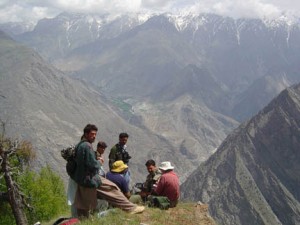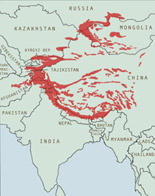
One of the most significant and iconic photos of snow leopards of all time. George Schallers’ photo of a female snow leopard in Chitral Valley Pakistan, taken in 1971, was the first cat ever to be photographed in the wild. (c) George Schaller and National Geographic.
In 1972, the International Union for the Conservation of Nature, (IUCN), placed the snow leopards of Pakistan on the endangered species list.
Snow Leopard numbers
It is estimated there are between 200 and 420 snow leopards in Pakistan’s northern mountains in the areas known as Khyber-Pakhtunkhwa, Gilgit-Baltistan and Azad Jammu and Kashmir.
Although the number of cats is small it is designated as the world’s third largest snow leopard population by size (along with India). Therefore it is critical that snow leopards in Pakistan be protected and local people, local agencies like National Parks of Pakistan and conservation agencies work to save this population. In these magnificent mountain ranges the snow leopard shares its habitat with prey species like markhor (wild goat), Marco Polo sheep, Himalayan Ibex (wild goat), blue sheep and musk deer.
Habitat
The total snow leopard habitat available in Pakistan has been estimated at around 80,000 square km and includes four high mountain systems – the Hindu Kush, the Pamirs, the Karakoram and the Himalayas.

Dr Rod Jackson of the Snopw Leopard Conservancy training wildlife monitors in mountains of Pakistan. (c) SLC.
Threats to snow leopards in Pakistan are similar to threats facing the species in other countries. There is still illegal hunting of snow leopard prey species which reduces the numbers for snow leopards to feed on. Vast areas of habitat have been fragmented and disrupted by villages expansion over the years. As in other range countries villagers also kill snow leopards in retaliation for the cats’ taking their domestic livestock. A 2010 study of snow leopard scat found that up to 70 percent of the species’ diet in the Gilgit-Baltistan region comes from domestic sheep, cattle, and other domestic animals. In order to protect their livelihoods we know some herders have killed snow leopards in retaliation for preying on their livestock.
Also the impact of many years of military activities in the region has also had an impact on snow leopards.
Organisations working to protect snow leopards in Pakistan.

A photo showing domestic sheep and goats presumed to have been killed by a snow leopard in the mountains of Pakistan. Livestock insurance programs re-imburse villagers when a cat kills their livestock as long as they do not kill the snow leopard in retaliation. (c) Shafqat Hussain.
Project Snow Leopard (PSL) was founded in 1999 by Shafqat Hussain and is a partnership between the community and private enterprise now supporting a livestock insurance program to compensate local farmers for losses caused by snow leopards. Dr Hussain has a Doctorate from Yale, and received an Associate Laureate Rolex Award for Enterprise in 2006, and was also awarded the National Geographic Society’s Emerging Explorer in 2009. Since 1998, close to U.S. $7,000 has been paid out in compensation for lost animals, and $13,000 invested on improving livestock corrals and other infrastructure. Meanwhile, the snow leopard population seems to have remained stable. Project Snow Leopard has been supported by the Snow Leopard Conservancy, UK Royal Geographic Society, the Whitley Fund and the Snow Leopard Trust (SLT).
In 2006 Project Snow Leopard was incorporated into the new NGO, Baltistan Wildlife Conservation and Development Organization, which Shafqat continues to advise. Ghulam Mohammed provides local leadership and coordination.
The Snow Leopard Foundation Pakistan, under the Directorship of Dr Muhammad Ali Nawaz, has its head office in the capital Islamabad but has two program offices in the heart of snow leopard territory, one in Gilgit, Baltistan and one in Chitral.

Photograph of snow leopard looking into remote camera. (c) Richard Bischof and Muhammad Ali Nawaz, Snow Leopard Foundation Pakistan.
The SLF is involved in a number of projects with other partners. One is a three year camera trapping survey with scientists of the Norwegian University of Life Sciences. The SLF also has a long term program in place with the Snow Leopard Trust. They also have support from the US Agency for International Development (USAid) Ambassador’s Fund.
Chitral District is one of Pakistan’s key snow leopard habitats, located high in the Hindu Kush Mountains on the western edge of Khyber Pakhtunkhwa Province. During winter local people have sightings of snow leopards close to an area known as Toshi Game Reserve. The valleys in this area are very remote and have not been involved in many conservation projects but are very important for long term snow leopard populations to survive in Pakistan.
Threats to snow leopards in Chitral are often due to snow leopards killing domestic livestock. Villagers have been known to respond with retribution killing and poaching and in 2011 two snow leopards were trapped after being thought responsible for livestock losses. The SLF and SLT together are working on improving the quality of livestock corrals to stop snow leopards getting to sheep and goats as well as educational events aimed at local children to teach them about the value of the snow leopard.
Getting village women involved is often a successful community conservation strategy and in Chitral women play a central role in livestock management and the SLF is now including them in training. About 7000 local people are involved in these programs.
The Snow Leopard Trust has been working in Pakistan since 1995. They partner with the local Snow Leopard Foundation (SLF) to support fulltime and part-time staff to increase conservation efforts such as community education, remote camera trapping to get data on cat numbers and the Snow Leopard Enterprises scheme supporting local women in the making and selling of handcrafts.
The Snow Leopard Conservancy has worked with communities since 2004, with conservation and education activities in Skyo and Hushe villages in Baltistan. The SLC partner in Baltistan is Project Snow Leopard, which works under the umbrella of the Balistan Wildlife Conservation & Development Organization. Some of the activities undertaken to date include building predator-proof corrals for livestock, improved livestock guarding and livestock insurance programs, environmental education, outreach, and community-based monitoring using snow leopard sign surveys, periodic prey counts and camera trap surveys.
Panthera, the Snow Leopard Trust (SLT) and Wildlife Conservation Society (WCS) are collaborating on snow leopard surveys and conservation actions in Gilgit-Baltistan Province (formerly the Northern Areas). WCS is active in the Northern Areas, but focuses primarily on community-based conservation of mountain ungulates like markhor, blue sheep and ibex which are often snow leopard prey specie). A joint office was established in Gilgit (capital of Gilgit-Baltistan) in late 2009. Thus far, range surveys and threat assessments have been initiated and will be expanded in the coming months.
READ ALL THE BLOG POSTS ON SNOW LEOPARDS IN PAKISTAN.



